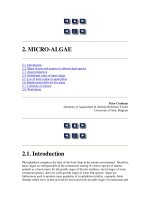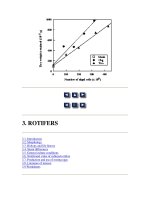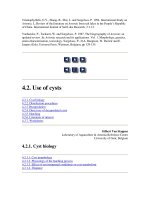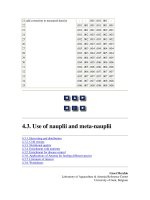Tài liệu Manual on the Production and Use of Live Food for Aquaculture - Phần 1 pptx
Bạn đang xem bản rút gọn của tài liệu. Xem và tải ngay bản đầy đủ của tài liệu tại đây (81.5 KB, 15 trang )
Manual on the Production and Use of
Live Food for Aquaculture
Table of Contents
FAO FISHERIES TECHNICAL PAPER
361
Edited by
Patrick Lavens and Patrick Sorgeloos
Laboratory of Aquaculture and Artemia Reference Center
University of Ghent
Ghent, Belgium
Food and Agriculture Organization of the United Nations
Rome, 1996
The designations employed and the presentation of material in this publication do not
imply the expression of any opinion whatsoever on the part of the Food and Agriculture
Organization of the United Nations concerning the legal status of any country, territory,
city or area or of its authorities, or concerning the delimitation of its frontiers or
boundaries.
M-44
ISBN 92-5-103934-8
All rights reserved. No part of this publication may be reproduced, stored in a retrieval
system, or transmitted in any form or by any means, electronic, mechanical,
photocopying or otherwise, without the prior permission of the copyright owner.
Applications for such permission, with a statement of the purpose and extent of the
reproduction, should be addressed to the Director, Information Division, Food and
Agriculture Organization of the United Nations, Viale delle Terme di Caracalla, 00100
Rome, Italy.
© FAO 1996
Table of Contents
PREPARATION OF THIS DOCUMENT
1. INTRODUCTION
2. MICRO-ALGAE
2.1. Introduction
2.2. Major classes and genera of cultured algal species
2.3. Algal production
2.3.1. Physical and chemical conditions
2.3.1.1. Culture medium/nutrients
2.3.1.2. Light
2.3.1.3. pH
2.3.1.4. Aeration/mixing
2.3.1.5. Temperature
2.3.1.6. Salinity
2.3.2. Growth dynamics
2.3.3. Isolating/obtaining and maintaining of cultures
2.3.4. Sources of contamination and water treatment
2.3.5. Algal culture techniques
2.3.5.1. Batch culture
2.3.5.2. Continuous culture
2.3.5.3. Semi-continuous culture
2.3.6. Algal production in outdoor ponds
2.3.7. Culture of sessile micro-algae
2.3.8. Quantifying algal biomass
2.3.9. Harvesting and preserving micro-algae
2.3.10. Algal production cost
2.4. Nutritional value of micro-algae
2.5. Use of micro-algae in aquaculture
2.5.1. Bivalve molluscs
2.5.2. Penaeid shrimp
2.5.3. Marine fish
2.6. Replacement diets for live algae
2.6.1. Preserved algae
2.6.2. Micro-encapsulated diets
2.6.3. Yeast-based diets
2.7. Literature of interest
2.8. Worksheets
Worksheet 2.1.: Isolation of pure algal strains by the agar plating technique
Worksheet 2.2.: Determination of cell concentrations using haematocytometer according
to Fuchs-Rosenthal and Burker.
Worksheet 2.3.: Cellular dry weight estimation of micro-algae.
3. ROTIFERS
3.1. Introduction
3.2. Morphology
3.3. Biology and life history
3.4. Strain differences
3.5. General culture conditions
3.5.1. Marine rotifers
3.5.1.1. Salinity
3.5.1.2. Temperature
3.5.1.3. Dissolved oxygen
3.5.1.4. pH
3.5.1.5. Ammonia (NH
3
)
3.5.1.6. Bacteria
3.5.1.7. Ciliates
3.5.2. Freshwater rotifers
3.5.3. Culture procedures
3.5.3.1. Stock culture of rotifers
3.5.3.2. Upscaling of stock cultures to starter cultures
3.5.3.3. Mass production on algae
3.5.3.4. Mass production on algae and yeast
3.5.3.5. Mass culture on yeast
3.5.3.6. Mass culture on formulated diets
3.5.3.7. High density rearing
3.5.4. Harvesting/concentration of rotifers
3.6. Nutritional value of cultured rotifers
3.6.1. Techniques for (n-3) HUFA enrichment
3.6.1.1. Algae
3.6.1.2. Formulated feeds
3.6.1.3. Oil emulsions
3.6.2. Techniques for vitamin C enrichment
3.6.3. Techniques for protein enrichment
3.6.4. Harvesting/concentration and cold storage of rotifers
3.7. Production and use of resting eggs
3.8. Literature of interest
3.9 Worksheets
Worksheet 3.1. Preparation of an indicator solution for determination of residual chlorine
4. ARTEMIA
4.1. Introduction, biology and ecology of Artemia
4.1.1. Introduction
4.1.2. Biology and ecology of Artemia
4.1.2.1. Morphology and life cycle
4.1.2.2. Ecology and natural distribution
4.1.2.3. Taxonomy
4.1.2.4. Strain-specific characteristics
4.1.3. Literature of interest
4.2. Use of cysts
4.2.1. Cyst biology
4.2.1.1. Cyst morphology
4.2.1.2. Physiology of the hatching process
4.2.1.3. Effect of environmental conditions on cyst metabolism
4.2.1.4. Diapause
4.2.2. Disinfection procedures
4.2.3 Decapsulation
4.2.4. Direct use of decapsulated cysts
4.2.5. Hatching
4.2.5.1. Hatching conditions and equipment
4.2.5.2. Hatching quality and evaluation
4.2.6. Literature of interest
4.2.7. Worksheets
Worksheet 4.2.1.: Procedure for estimating water content of Artemia cysts
Worksheet 4.2.2.: Specific diapause termination techniques
Worksheet 4.2.3.: Disinfection of Artemia cysts with liquid bleach
Worksheet 4.2.4.: Procedures for the decapsulation of Artemia cysts
Worksheet 4.2.5.: Titrimetric method for the determination of active chlorine in
hypochlorite solutions
Worksheet 4.2.6.: Artemia hatching
Worksheet 4.2.7.: Determination of hatching percentage, hatching efficiency and
hatching rate
4.3. Use of nauplii and meta-nauplii
4.3.1. Harvesting and distribution
4.3.2. Cold storage
4.3.3. Nutritional quality
4.3.4. Enrichment with nutrients
4.3.5. Enrichment for disease control
4.3.6. Applications of Artemia for feeding different species
4.3.6.1. Penaeid shrimp
4.3.6.2. Freshwater prawn
4.3.6.3. Marine fish
4.3.6.4. Freshwater fish
4.3.6.5. Aquarium fish
4.3.7. Literature of interest
4.3.8. Worksheets
Worksheet 4.3.1.: Standard enrichment for Great Salt Lake Artemia.
4.4. Tank production and use of ongrown Artemia
4.4.1. Nutritional properties of ongrown Artemia
4.4.2. Tank production
4.4.2.1. Advantages of tank production and tank produced biomass
4.4.2.2. Physico-chemical conditions
4.4.2.3. Artemia
4.4.2.4. Feeding
4.4.2.5. Infrastructure
4.4.2.6. Culture techniques
4.4.2.7. Enrichment of ongrown Artemia
4.4.2.8. Control of infections
4.4.2.9. Harvesting and processing techniques
4.4.2.10. Production figures and production costs
4.4.3. Literature of interest
4.4.4. Worksheets
Worksheet 4.4.1: Feeding strategy for intensive Artemia culture.
4.5. Pond production
4.5.1. Description of the different Artemia habitats
4.5.1.1. Natural lakes
4.5.1.2. Permanent solar salt operations
4.5.1.3. Seasonal units
4.5.2. Site selection
4.5.2.1. Climatology
4.5.2.2. Topography
4.5.2.3. Soil conditions
4.5.3. Pond adaptation
4.5.3.1. Large permanent salt operations
4.5.3.2. Small pond systems
4.5.4. Pond preparation









